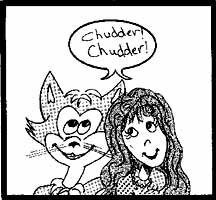
On Communicating with Cats
Domestic cats are an oddity in the animal kingdom. All other domesticated mammals are social animals that travel naturally in herds, flocks, or packs. Cats would rather be alone.
Since people are also social animals, it's no wonder the two species have suffered from occasional missed signals as they've tried to get along together over the centuries. Successful dog training, for example, depends on a human's ability to mimic the natural authority of a pack leader; once a dog has decided its owner is, so to speak, a top dog, then discipline comes easily. There's nothing in a cat's instinctive background to make it believe in a higher authority.
Nevertheless, perhaps for their own amusement as much as practical reasons, cats usually attempt to gain the approval of the people with whom they live. They also develop various ways of communicating preferences and wants. With most kinds of domestic cat, that involves various vocalizations--yowling, growling, purring. Eventually their owners learn what to do.
Sometimes there are exceptions. For years in my home, we had what amounted to his-and-hers cats. The cat that selected my husband as preferred person also got along quite well with me, but my cat would have as little as possible to do with my husband (to the point of setting up camp in the attic when I was out of town). No amount of kindly attention from him could convince the cat he was worthy of acceptance. Because she had been rescued from the pound, we assumed she had been maltreated by a man before we got her and thus was unwilling to trust another one.
Then, after a conference in San Diego, my husband had a chance to visit its famous zoo. The zoo had just opened its new tiger habitat, and the big cats were a featured attraction. With the items of information on the tiger enclosure was a speaker and pushbutton that let observers hear recorded tiger vocalizations.
Tigers, like all felines, growl when they have reasons to be aggressive or defensive. Like lions, they also roar. That's a signal to potential competitors for territory, food, or mates. A wise tiger can tell from the volume and tone of a roar whether it's worth doing battle without even seeing the animal doing the roaring. That noise also serves another purpose: it can startle any possible prey hiding nearby into giving away its location. (That's the principle our northern wild felines use---the yell of a hunting lynx is meant to be genuinely hare-raising.)
The San Diego recording provided a third tiger sound. It was a kind of throaty chuckle, a noise something like a trill made far back in the mouth, called a chudder. Tigers chudder by way of greeting one another. It's the sound they make returning to their dens---a kind of tigerish equivalent of "Hi, dear, I'm home." The tiger keepers, the recording noted, imitated the sound when they entered the enclosure. The tigers often answered in kind. The experiment was irresistible. When he returned home from the trip, my husband tried chuddering at my cat. Although the cat looks more like a dust bunny than a jungle tiger, tiger-talk worked perfectly. She came running, emitting meows and a rather soprano chudder-like sound. She's doted on him ever since.
"Now I begin to understand how Helen Keller felt," he said. "I can communicate!" Talking it over, we decided that I had always attempted to address cats in their own tongue, imitating back the noises they made without paying much attention to the results. He'd used English only, good enough for important noises like "food" or "out" but inadequate for friendship with an innately wary cat.
Since then, we've discovered that chuddering gets the attention of strange cats, and sometimes their quick acceptance. Guests who've chuddered at my formerly standoffish cat have become her instant friends.
One experiment doesn't prove anything, but I'd like to think we've found what scientists would call suggestive evidence of a nice continuity in feline communications, from tigers to house cats. At least, we've found a way to communicate positive intentions toward one cat.





